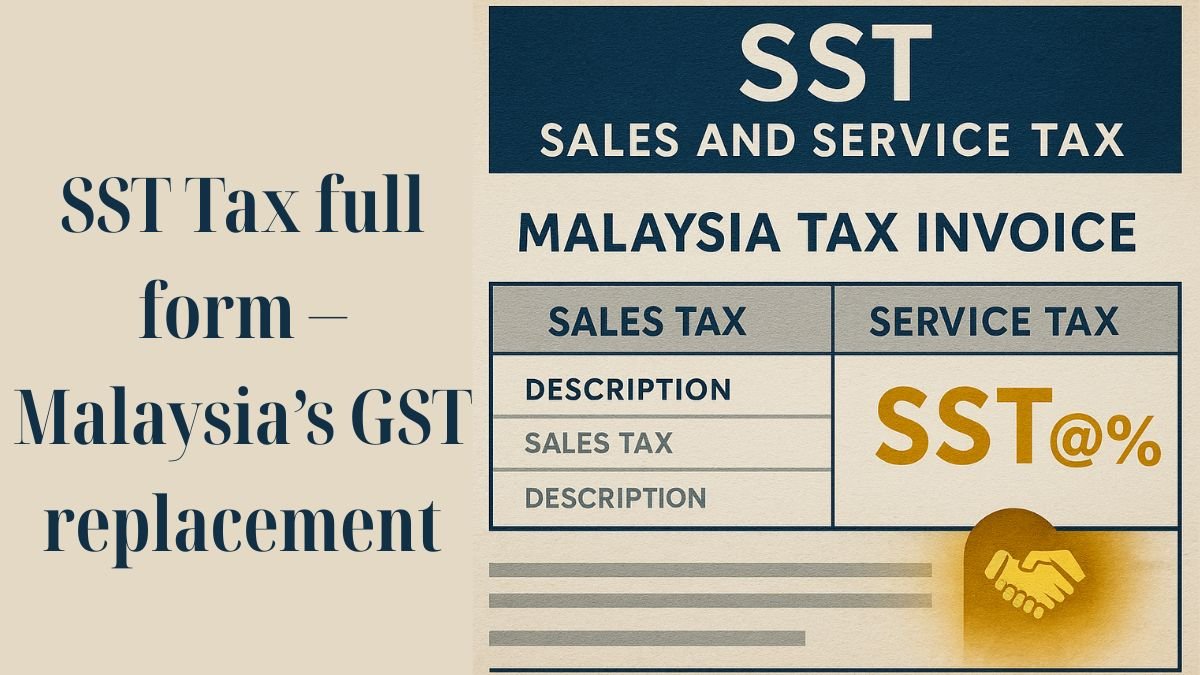
If you’ve ever searched for “SST tax full form” online, you’ve probably encountered two different meanings—Sales and Service Tax (used in countries like Malaysia) and Streamlined Sales Tax (used in the United States). Although they share the same acronym, the concepts serve different purposes depending on the country.
This article explores both interpretations of SST, how they work, where they’re applied, and why it’s important to know the difference.
SST Tax Full Form: What Does SST Stand For?
Let’s break down the full forms of SST tax:
- Sales and Service Tax (SST) – Commonly used in Malaysia and some Southeast Asian nations.
- Streamlined Sales Tax (SST) – A U.S.-based initiative to simplify sales tax collection across multiple states.
Although both involve sales tax systems, their applications and impact differ widely.
1. What Is Sales and Service Tax (SST)?
The Sales and Service Tax (SST) system is a single-stage tax levied on imported and locally manufactured goods, as well as certain prescribed services. It is implemented primarily in Malaysia, where it replaced the Goods and Services Tax (GST) in 2018.
SST Has Two Main Components:
- Sales Tax – Levied on manufacturers or importers of taxable goods
- Service Tax – Imposed on specific service providers like hotels, telecoms, and restaurants
The current SST tax rate in Malaysia is:
- Sales Tax: 5% or 10%, depending on the product
- Service Tax: Flat 6%
The SST system is designed to simplify compliance, especially for small and medium-sized enterprises (SMEs).
Key Features of Sales and Service Tax (SST)
- Applied only once in the supply chain (single-stage)
- Not refundable as input tax (unlike GST or VAT)
- Requires businesses to maintain separate records for sales and service tax
- Simplified filing process for manufacturers and service providers
This makes SST ideal for domestic consumption taxation without affecting the final consumer with multiple tax layers.
2. What Is Streamlined Sales Tax (SST)?
In the United States, SST stands for Streamlined Sales Tax, a multistate initiative launched to simplify sales tax collection across states, especially after the rise of online commerce.
It addresses the complexity of U.S. tax rules, where each state has its own sales tax regulations. The Streamlined Sales Tax (SST) project helps businesses comply with varying state laws via a centralised system. "
Goals of SST in the U.S.:
- Simplify tax administration
- Standardise definitions and rules
- Provide tools for streamlined sales tax registration
- Offer voluntary compliance benefits (like audit protection)
This initiative is especially helpful for e-commerce companies that sell across multiple U.S. states.
Streamlined Sales Tax Registration
Businesses selling in SST-participating states can use Streamlined Sales Tax Registration to:
- Register in multiple states with a single application
- Avoid penalties under voluntary disclosure programs
- Access Certified Service Providers (CSPs) who handle filing and remittance
This is a game-changer for small to mid-sized U.S. businesses expanding their reach without increasing their administrative burden.
SST vs GST: What's the Difference?
It’s common to confuse SST with GST (Goods and Services Tax). Let’s simplify it:
|
Feature |
SST (Sales & Service Tax) |
GST (Goods & Services Tax) |
|
Tax Structure |
Single-stage |
Multi-stage |
|
Input Tax Credit |
Not available |
Available |
|
Tax Rate |
5%, 6%, or 10% |
Standard rate (e.g., 6% in Malaysia before GST was repealed) |
|
Documentation |
Simpler |
More complex |
Common Questions About SST
What Is SST Tax in India?
India does not use the SST (Sales and Service Tax) system. Instead, it follows a comprehensive GST regime that subsumes all indirect taxes like VAT, service tax, and excise duty into one structure.
What Is SST ID Number?
In Malaysia or the U.S., businesses registered under SST are issued a unique tax ID. This SST ID number is used for compliance, filing, and verification purposes.
Why Understanding SST Matters
Whether you're a business owner, accountant, or student, knowing what SST full form stands for—and where it applies—helps in:
- Tax registration and compliance
- Cross-border business setup
- Understanding customer invoicing and pricing
- Avoiding tax penalties and overcharging
Final Thoughts
So the next time you search for SST tax full form, remember it has two key interpretations:
- In countries like Malaysia, it stands for Sales and Service Tax (SST), a single-stage tax levied on imported and locally manufactured goods.
- In the United States, it refers to the Streamlined Sales Tax (SST) initiative that simplifies multistate tax compliance.
👉 Need help understanding tax compliance or choosing the right tax system for your business?
Visit www.callmyca.com and consult with a tax expert today.











